| Tun Abdul Razak Complex | |||||||||||||||
|---|---|---|---|---|---|---|---|---|---|---|---|---|---|---|---|
 Komtar Tower in 2023. | |||||||||||||||
| Record height | |||||||||||||||
| Tallest in Southeast Asia from 1 January 1985 to 10 November 1986[I] | |||||||||||||||
| Preceded by | 6 Shenton Way | ||||||||||||||
| Surpassed by | One Raffles Place | ||||||||||||||
| General information | |||||||||||||||
| Status | Completed | ||||||||||||||
| Architectural style | Brutalism | ||||||||||||||
| Location | Penang Road, George Town, Penang, Malaysia. | ||||||||||||||
| Coordinates | 5°24′52″N 100°19′45″E / 5.4145°N 100.3292°E | ||||||||||||||
| Groundbreaking | 1 January 1974 | ||||||||||||||
| Construction started |
| ||||||||||||||
| Topped-out | 1 January 1985 | ||||||||||||||
| Completed |
| ||||||||||||||
| Opening |
| ||||||||||||||
| Inaugurated | 1 January 1977 | ||||||||||||||
| Cost | RM 279.5 million[lower-alpha 1] | ||||||||||||||
| Owner | |||||||||||||||
| |||||||||||||||
| Design and construction | |||||||||||||||
| Architect(s) | Lim Chong Keat Buckminster Fuller Architects Team 3 | ||||||||||||||
| Developer | Penang Development Corporation | ||||||||||||||
| Structural engineer | Ove Arup & Partners | ||||||||||||||
| References | |||||||||||||||
| I. ^ [1][2][3][4] | |||||||||||||||
The Tun Abdul Razak Complex (abbrev. Komtar), formerly the Penang Urban Centre, is a civic complex within the central business district of George Town in the Malaysian state of Penang. At the time of its completion in 1985, Komtar Tower, at 231.7 metres (760 ft), was the second tallest building in Asia and the tallest in Southeast Asia until 1986 when it was surpassed by One Raffles Place in Singapore. Other buildings in the complex include a hotel building, four shopping malls, an urban park and a central transportation hub. The complex contains 1,420,000 square feet (132,000 m2) of office and retail space on a 27-acre (11 ha) superblock. It currently houses the administrative offices of the Penang state government and the chief minister of Penang.[5]
The main complex was built between 1974 and 1986, at an initial cost of RM279.5 million (equivalent to RM642.5 million in 2023). Plans for a civic and commercial complex within central George Town was first proposed by the state government in 1962, and was approved in 1969 by Chief Minister Lim Chong Eu. The project was extensively studied in 1971 and was implemented by the Penang Development Corporation in 1972.[6] The brutalist complex and skyscraper was designed by Lim Chong Keat, and was to be built in five phases, although only two were completed in its original form. The three phases were later repurposed and built in separate periods between 1996 and 2019. Renovations of the main complex in 2015 extended the height of the building to 249 metres (817 ft).[7]
Receptions of Komtar's construction are mixed. Described as a "city within a city", the complex was seen as ahead of its time, and was the largest urban regeneration project in Malaysian history.[8] In spite of this, it ultimately failed to achieve its aims of rejuvenation.[9] Komtar was also controversial for causing mass urban displacements and the demolition of a portion of the city's heritage quarter, leading to a rise of opposition that indirectly led to the creation of the heritage preservation movement in Malaysia.[10] In its later years, the complex was plagued by neglect and dilapidation from insufficient maintenance.[11] Despite its controversial status, Komtar has come to symbolise Penang's post-industrialisation prosperity and is one of the most recognised landmarks of George Town.[12] It is also hailed as the last "great national symbols of the 1970s".[13]
Background
Site
 Maxwell and Penang Roads, c.1930s.
Maxwell and Penang Roads, c.1930s. Windsor Building and Capitol Theatre, c.1937.
Windsor Building and Capitol Theatre, c.1937. Magazine Circus, facing Gladstone Road, c.1930s.
Magazine Circus, facing Gladstone Road, c.1930s.
The site from which Komtar now occupies was originally a stretch of the Prangin River, which ran through a swamp. Upon the outbreak of the Napoleonic Wars, the construction of a defensive stone canal began under probable directions from the British East India Company in 1804.[14] The canal was approximately 50 to 80 feet (15 to 24 m) wide. Its base was constructed with bakau pillars and shorewood, and was filled with granite blocks. The canal was meant for agricultural and commercial uses, and marked the furthest boundaries of George Town at the time.[15]
The location of the canal, being at the very end of the town, was first noted by the Malay population under the name Ujong Pasir, and was later remarked by the local Chinese population in Hokkien as Sia Boey, both coincidentally carrying the same meaning of the "end of the village" (other historians suggested that the term Sia Boey might also mean "a place to sell scrap, or cheap sundry").[16] In 1806, a marketplace was set up at Sia Boey, which evolved into the Sia Boey Market.[17] Since the 1880s, the market centered around an iron market hall, before closing down permanently in 2004.[18] The canal was narrowed in the 1890s to a width of 20 feet (6.1 m) and a depth of 5 feet (1.5 m).[19] In the 1930s, the area witnessed an economic boom where new businesses were established along the canal.[20]
Adjacent to the site was the Magazine Circus, a roundabout converging on a junction of six roads – Macalister, Dato' Keramat, Penang, Magazine, Brick Kiln and Gladstone Road. The Malays named it Simpang Enam ("the six-way junction"), while the Chinese called it Go Pha Teng ("the five lamps"), as a reference to street lamps set up at the junction. In 1928, the first traffic lights in Penang were set up at the roundabout.[21] During the Japanese bombing of Penang in December 1941, Sia Boey Market received a direct hit from a bomb, killing hundreds of market-goers.[18]
Creation of Komtar

In 1962, the Penang state government proposed to develop a hawker centre at an area around Prangin Road.[8] Malayan architecture firm Malayan Architects Co-Partnership was contracted for the project, but it stalled within months.[22]
When Lim Chong Eu took up the position of chief minister in 1969, he was immediately confronted with the rescindment by the Malaysian federal government of George Town's free port status, which sparked massive unemployment, brain drain and urban decay in the city.[23] As a means to address these challenges, Lim ordered the establishment of the Penang Development Corporation (PDC) as a development arm of the state government.[24] The PDC focused on resolving urban overcrowding by constructing inexpensive multi-storey apartment blocks. Four sites within George Town were designated by the PDC as "Comprehensive Development Areas" for urban redevelopment, which included the construction of low-cost flats on reclaimed land and urban renewal programmes.[25]
In 1969, the PDC approved a Central Area Planning Unit (CAPU) for monitoring residential and highway infrastructural projects in George Town. Between 1969 and 1970, the original hawker centre proposal around Prangin Road was redesignated by the CAPU as the "Central Area Redevelopment Plan", a precursor of Komtar.[6]
History
Design
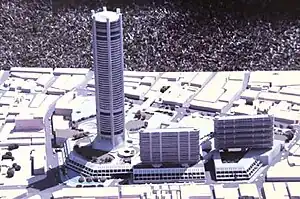
In 1970, the state government selected Singaporean architectural firm Architects Team Three (AT3) for the CAPU, with Lim Chong Keat as lead architect.[13] Ove Arup was selected as the civil and structural engineers for the project.[26] Plans for a new urban centre was first announced publicly on 18 November 1970.[27] The CAPU conducted extensive planning studies of the Urban Centre in 1971.[6] It was concluded in August 1972 that the recommended site of the urban centre should be bounded by the Penang, Prangin, Magazine Roads and Beach Street, on a site 22.4 acres (9.1 ha) in area, with parking for 3,000 vehicles.[28] Additional input from CAPU were made from experts in the University of Penang and a traffic consultant.[8]
Planning of the complex is divided into five different phases; the main complex occupies the first two phases.[12] The first phase, with 301,000 square feet (28,000 m2) in land area, would involve a four-storey retail podium (phase 1A), a geodesic dome (phase 1D) and a central skyscraper.[29][28] It was aimed at combating against the declining inner-city trade after the 1960s, by integrating a commercial district into the civic centre with a Western-style shopping arcade, where emerging middle-class shoppers living in the city's suburbs can shop in.[30] The shopping arcade, which occupies three out of four-storeys of the podium, contains 460,000 square feet (43,000 m2) of retail space.[31] The podium also houses a bus terminal, a public theater, a national archives, police and fire stations, and a rooftop indoor orchid garden with a reflective pool.[32][33] A hotel for travellers, known as the Hotel De Jour, would be within the third floor of the podium.[34]
The geodesic dome (phase 1D) is positioned above the podium.[35] The geodesic dome, positioned directly adjacent to the reflective pool, was originally 48 metres (157 ft) in diameter and designed as a multipurpose hall with 1,875 seats.[36][37] It was designed as an all-aluminium, column-free structure, entirely prefabricated from computer designs.[38] The interior of the structure was covered with K-13 spray foam for better indoor acoustics.[39] The dome was influenced by the designs of Buckminster Fuller – a special consultant of the CAPU who supervised its construction.[32][40] The skyscraper carries in the form of a 45 or 60-storey 12-sided cylinder column and was designed with 640,000 square feet (59,000 m2) of office space.[31][41] 32 high speed lifts are fitted in the complex, with 24 in the tower, each capable of travelling at 1,200 feet (370 m) per minute; while six pairs of escalators are installed in the podium.[34]
The second phase involves the extension of the podium, with 2,000,000 square feet (190,000 m2) of retail space and several civic amenities.[29] To accommodate the displaced residents from the construction site, three 17-storey apartment blocks were allocated for the two phases.[12] The first block, with 194 flats, is designed as a "controlled social programme", planned and sold for selected families of mixed races; these blocks also house several amenities, where access corridors between them are thought of as "streets". The three apartment blocks would house 800 households, with emphasis on accommodating lower income groups.[42] These communities would be linked to a clubhouse, a library, communal swimming pools and several cafes.[32] All three residential blocks are connected with enclosed bridges on the ninth floor.[31]
.jpg.webp)
Under Lim Chong Eu's vision, the Urban Centre is conceived to be a step in "progressive" urban planning on behalf of the Penang state government.[43] The centre was expected to ease congestion and clear the slums from George Town's city centre which sprung up after the 1960s recession.[44] The complex was described by Lim as a "sign of collaboration" between the federal government and the Penang state government, and "marks a new era for the city of George Town".[43] It was given priority in the New Economic Policy championed under Prime Minister Abdul Razak's administration, who stated that the success of this project "will change the outlook of George Town from a colonial heritage to a city reflecting a Malaysian society".[45] Location wise, it was designed to link with a new coastal highway system that leads to a cross-strait linkage and the Penang International Airport.[43] Construction of the first phase was projected to raise the total revenue in the region from RM114,000 in 1974 to around RM3 million in 1984, which would be used as funds for maintenance and upkeep for the civic centre's amenities.[46][32]
Original construction (1972–1986)

In 1972, the PDC began the implementation of the first phase of the master plan.[32] 182,516 square feet (16,956.3 m2) of land was owned by the City Council and state government for the construction of the first phase. Between 1972 and 1973, the state government acquired the necessary land for construction, predominantly from inherited landlords of the Straits Chinese elite.[47] The total cost of the land acquisition was estimated at RM21 million in 1973 value.[48]
Before the construction, an estimated 769 residential units, 304 shops, 14 industries, four cinemas, three schools, a vehicles' office, a post station and a fire station around the site were demolished.[49] The demolition displaced 3,175 residents to other parts of the city, including Jelutong, Bayan Baru and the PDC-funded Macallum Street Ghaut Flats.[47] The Magazine Circus and a huge section of Gladstone Road was removed as well.[50] By 1973, the state government projected the total cost of the entire complex at RM200 million (RM1.04 billion in 2023 value);[51] the first phase at RM77.6 million, with RM40.8 million allocated for the skyscraper.[48] The call of tender for the project's construction concluded in December that year.[52]
.jpg.webp)
Piling works of the complex concluded at the end of 1973.[53] Groundwork of the complex was supported by a three-metre thick reinforced concrete raft foundation, with 860 composite piles up to 54 metres (177 ft) deep.[54][55] These enabled the complex to be resistant to tremors up to four on the Modified Mercalli scale.[55] Construction of the first phase of the complex began on 1 January 1974, in a ceremony officiated by Malaysian prime minister Abdul Razak Hussein.[45] It took place on a 0.4 hectares (1 acre) site, which involves 70 units of retail and office space, where 34 per cent of the total area was reserved to Bumiputeras.[56] A two-week exhibition regarding the urban scheme was held near the construction site between 10 to 24 January 1974.[57] In May 1974, work progressed to the main tower block.[58] The four-storey podium was completed within two years and received a soft opening on 2 December 1976.[56] The federal government bought 91,000 square feet (8,500 m2) of office space at Komtar in July 1980.[59]

In January 1983, construction moved to phase two, subdivided into five areas; an electric substation (phase 2A), a department complex (phase 2B), an 11-storey car park with 750 parking spaces (phase 2C), the geodesic dome (phase 2D) and an 11-acre (480,000 sq ft) rooftop garden above the main podium (phase 2E).[lower-alpha 4] The total cost of the second phase was estimated at RM110 million (RM265 million in 2023 value).[60] A further RM7 million was allocated for the geodesic dome.[39] However, work was abruptly halted when a major fire broke out on the tower between 23 and 24 January, which gutted the 41st to 47th floors.[61] The fire was reportedly visible across the Penang Strait at Perai, and required the mobilisation of fire fighting units as far as Nibong Tebal.[62] Investigations determined that it was likely caused by welding sparks.[63]
Construction resumed by mid-1983, reaching the 60th floor by 1984.[64] The skyscraper structurally topped out at the 65th floor on 1 January 1985.[65] In May that year, plans for the three 17-storey apartment blocks were scrapped and replaced with a single hotel building.[66] The hotel opened as the Shangri-La Inn in 1986.[67][68] The main framework for the geodesic dome was completed and inaugurated in July by Tunku Abdul Rahman.[36][38] A pedestrian mall was constructed in mid-1990 as the final adjoining part of phase two, occupying half of Maxwell Road and the Prangin Canal, forcing the remnants of the adjacent Prangin Road to merge into a one road.[69] By 1990 the total cost of the first two phases rose to RM279.5 million (RM642.5 million in 2023 value), while the state government had collected RM185 million in revenue (RM425 million in 2023 value).[70]
.jpg.webp) Aerial view, 1981.
Aerial view, 1981.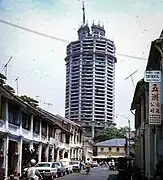 From Kuala Kangsar Road, 1983–1984.
From Kuala Kangsar Road, 1983–1984.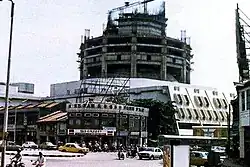 At the Magazine Circus, 1980.
At the Magazine Circus, 1980.
Retail expansion (1990–2000)
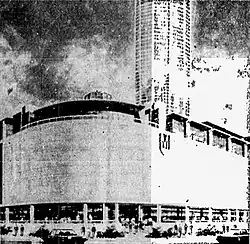
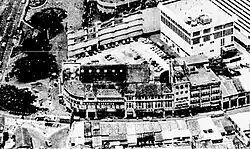
Below: Junction between Prangin and Penang Road, which includes the Capitol Theatre, prior to its demolition, c. 1992.
Plans for phase 2E, three and four were first drafted in 1990–1991. As early as 1989, a parcel of land situated at the junction of Prangin Road and Penang Road, designated phase 2E of the complex, was put up for sale.[71] In 1991, Malaysian retail chain Metrojaya submitted plans for Metro Plaza, a six-storey department complex for phase 2E.[72] The complex was to cost RM47 million with 340,000 square feet (32,000 m2) of retail space.[73] Metrojaya would acquire parcels of land necessary within that year.[73]
In early-1992, the project was scaled down to a five-storey department complex with 312,000 square feet (29,000 m2) of built-up area, with parking for 240 cars and a staff of 650. Preparation of Metro Plaza began in 1992 with the demolition of the Capitol Theatre and ten other businesses which sat at the site, while construction was projected to complete within three years.[74] The site remained dormant as of 1995 and it was only in 1996 that talks of construction resumed.[75][76]
For phase three, Japanese retail group Yaohan proposed to build a nine-storey RM129 million department complex, which was to be completed by 1993. The project sat on an 84,000 square feet (7,800 m2) plot of land running largely parallel to the Prangin Canal, next to phase 2E, and was to be built by Kumagai Gumi.[77] In 1992, citing its inability to allow majority local participation of the project as required, Yaohan rescinded the 1990 agreement, which led to a private takeover of the site by Lion Group. Demolition works for the site, which began in 1992, involved twelve shophouses, which became a "temporary" parking lot until December 1996.[78] In November 1996, the state government issued a construction ban of all structures beyond five storeys within the city-centre, threatening phase three's cancellation.[79] Eventually, Lion Group submitted an updated proposal in 1997, featuring a RM170 million 10-storey shopping complex named Mutiara Parade, which was approved with construction slated to start later that year and expected to finish by 1999.[78]
Phase four was an extension of the pedestrian mall, stretching 100 metres (330 ft) beyond Carnavon Street while removing the remnants of the partially cleared Maxwell Road.[69] In 1990, 155 traders along Prangin Road were relocated to within Komtar and Chowrasta Market in preparation for phase four.[69] Subsequently the extension was cancelled in favour of Prangin Mall, a 1,500,000 square feet (140,000 m2) shopping complex at a cost of RM200 million.[80] The complex was proposed to equip 73 escalators, two "bubble" lifts, an international food centre, six Parisian cafés, a garden mall and four cinemas with a combined total of 1,800 seats.[54] Excavation works for Prangin Mall began in 1996.[81] In December, while piling works were undertaken at the site, nearby residents lodged a police report, disclosing that cracks began to surface on over a hundred houses in surrounding areas and that ground subsidence was sighted.[82] Komtar reported similar occurrences, even though officials stated that the complex was not under danger.[54][83]
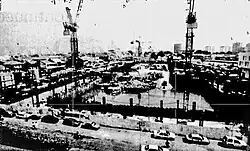
Investigations by the Malaysian Public Works Institute (Ikram) and Penang state government concluded that excavation and piling works at the Prangin Mall site led to the migration of underground water away from the city centre, leading to subsidence of the surrounding soil.[82][84] As a response, the state government requested Prangin Mall's developers to submit a geotechnical report on the flaw, although the report did not reach state officials until February 1997.[84] On 30 January, citing the developers' failure of compliance, Ikram issued a stop work order on Prangin Mall.[85] Ikram later expanded the stop work order to phase three, noting similar circumstances.[84]
By March 1997, there were over three hundred reports of houses with cracks.[83][86] Following this, the developers submitted three mitigation measures to the state government and was approved.[87] Mitigation works began in April and lasted for 53 days, costing the developers RM6 million.[88][89][90] Ultimately, after mitigation works were complete, the state government lifted the stop work order for Prangin Mall in June under a 20-point agreement.[91] The incident has since been described as a "crisis" or a "disaster".[92][93] The Asian financial crisis which began in late-1997 led to the cancellation of Metro Plaza and Mutiara Parade.[94][6] Only Prangin Mall was complete by mid-2000, which finally opened in 2001.[95]
Subsequent developments (2002–present)
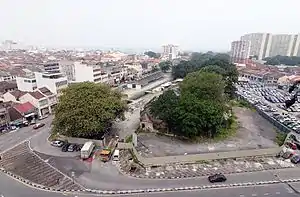
The cancellation of Mutiara Parade suspended any construction on phase three until October 2007, when construction began on 1st Avenue, an 11-storey 430,000 square feet (40,000 m2) shopping mall.[96][97] The development, costing RM300 million, was modeled after Raffles City Singapore.[98] Construction was completed in June 2010 and opened on 25 November 2010.[99]
Phase five, which occupied Sia Boey Market, was first planned in 1991 as a mixed retail, office and residential development. The land was sold in July 1991 at RM31 million to a private developer for potential development scheduled for 1995 or 1996, but was never built.[100] In 2002, it was planned as a centralised transportation hub, featuring a main interchange terminal of the Bayan Lepas light rail transit line, a proposed light rail transit line running along Penang Island.[6] In anticipation of future construction, Sia Boey Market closed in 2004, even though the site remained vacated for years due to uncertainties in the light rail transit project.[17]
In 2012, phase five was proposed to become an arts district known as the Penang Heritage Square, which featured the complete restoration of heritage shophouses at the site and the construction of a five-storey cultural centre.[101] This project was relocated to Macallum Street Ghaut in 2016 due to plans for an integrated transport hub at Sia Boey.[102] An urban park was later included within the phase, becoming the Sia Boey Urban Archaeological Park. The 2.53 acres (1.02 ha) park, which occupied a disused section of the Prangin Canal, began construction in 2015 and was completed in 2019.[103] The park opened on 9 November 2019.[104] In May 2023, the Malaysian federal government announced that construction of the Bayan Lepas light rail transit line, which includes a terminal at Komtar, would start in early-2024.[105]
Criticisms
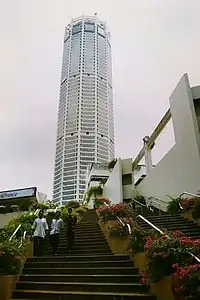
During its planning and initial construction, the project was questioned to be unnecessary by opposition politicians from the Democratic Action Party and Pekemas. Both parties vowed to scrap the entire masterplan if they gain control of the state government in the 1974 general elections.[106] After its construction, opposition came from its expansion through the Prangin Mall and Mutiara Parade projects, and the failure of the complex in achieving its desired objectives, which was to replace dilapidating city slums that sprung up after the 1960s recession in Penang with modernised city blocks.[107][108]
Lim Chong Keat, the complex's principal architect, was the younger brother of chief minister Lim Chong Eu, which generated accusations of nepotism over the former's selection in the position. Yeap Ghim Guan alleged that the state government paid RM10 million to AT3 for their involvement in the CAPU in 1974, which had been the firm Lim Chong Keat was leading.[44] In an article from the February-March 1976 issue of the Asian Statist magazine, it was alleged that the cost of construction of the megacomplex had inflated to RM500 million (RM1.91 billion in 2023 value), putting doubts on the state's capabilities to finance the entire project.[109] It was also argued that the compensation provided by the state government to displaced residents in the project were vastly insufficient.[110]
American architect Victor Papanek predicted in 1981 that Komtar would fail and become an "eyesore", creating congestion and pollution.[111] After its completion, criticisms shifted to accusations of gentrification.[112] Veerappen Veerathan described the project "will only bring RM200 million of misery".[113] Karpal Singh remarked in 1985 that Komtar is a "personal monument of Lim Chong Eu", calling it "his Taj Mahal".[114] The initial occupancy rates in the offices have led Lim Kit Siang to describe the complex and the contemporary Dayabumi Complex as "white elephants".[115] This was reflected by poor sales of office space in Komtar, which was impacted by severe office space gluts in 1984. While local, state and federal offices occupied the "low-zones" (10th to 28th floor) and "mid-zones" (29th to 43rd floor) of the skyscraper, the sale of "high-zone" office space to private sectors were reportedly "not encouraging".[116]
Furthermore, the controversy over Prangin Mall's construction which resulted in subsidence and damages on the city's heritage quarters have led to calls for the project's cancellation by local residents.[107] It was also feared that the debacle would have created irreversible damages to a substantial portion of the area.[117]
Decline and revitalisation efforts
While Komtar was one of the most popular shopping complexes in Penang in the late-1980s and early-1990s, its status as a premier retail hub declined dramatically in the late-1990s. Starting from the 1970s, the city centre suffered from mass depopulation from displacements of entire neighbourhoods and businesses directly caused by Komtar's construction.[12] Furthermore, by the 1990s, a combination of factors such as economic decline after the Asian financial crisis in 1997 and rising competition from newer and upscale shopping complexes in the outer suburbs such as Gurney Plaza and Penang Times Square exacerbated the decline. The complex was also poorly maintained and generally disliked by tenants due to its crammed and confusing interior layouts.[6]
Attempts of renovation were difficult as the Penang state government only owned one-thirds of all retail units in the complex, while the rest were bought and owned by private businesses, leading to serious disagreements on rental rates and occupancies.[118] In 2005, the two largest anchor tenants of the complex, Super Komtar and Parkson, ceased operations in rapid succession, which decimated foot traffic in the complex.[119] At the turn of 2008, it was estimated that 40 per cent of retailers in the complex had closed down.[6]
.jpg.webp)
With reduced local presence, the complex received an influx of migrant workers, primarily from Nepal, Myanmar, the Philippines and Indonesia, drawing similarities with Lucky Plaza in Singapore and Victoria Park at Hong Kong. Different floors of the complex housed individually segmented groups of immigrants of different nationalities, functioning as an agora for the diaspora.[120] Komtar is also host to numerous social issues such as homelessness, drug usage and vandalism.[121][122] These factors have caused the complex to develop a reputation of being "creepy and unsafe". Other developments such as Komtar Walk, launched in 2009 as a pedestrian mall, was plagued by legal disputes and was demolished then rebuilt in 2019.[123]
As early as 2001, the Penang state government initiated a programme to shift all government functions at Komtar to a new location at Seberang Perai described as a "mini Putrajaya". It was proposed that Komtar would become a hotel or a commercial centre once the relocation is complete, but the project never took off and was put on hold indefinitely in May 2003. The project was cancelled in 2008 under the newly elected government of Lim Guan Eng due to cost issues.[124] The stalemate over Komtar's development had led to Komtar state assemblyman Lim Gim Soon to propose to convert the complex into a Chinese secondary school.[125]
Several renovations were undertaken at this period, including one in October 2007 which costed RM10 million, and a RM15 million renovation project in April 2008 aiming at refurbishing the podium.[125][126] In 2010, the Penang state government launched plans to renovate the upper sections of the skyscraper.[127] The revitalisation effort, known as The Top, was launched in December 2012, costing RM180 million.[128] As part of the effort, three new floors were constructed, increasing the skyscraper's height to 248.9 m (817 ft).[129] A 16 metres (52 ft) skywalk, three bubble lifts, and a 90-metre-long (300 ft) rope course was added in subsequent renovations in 2018.[130][131]
 Junction between Komtar bus terminal and Prangin Mall.
Junction between Komtar bus terminal and Prangin Mall.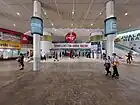 Main entrance of the complex.
Main entrance of the complex. Central atrium of phase two.
Central atrium of phase two. The Komtar Skywalk is billed as the tallest of its kind in Malaysia.
The Komtar Skywalk is billed as the tallest of its kind in Malaysia. Alternate entrance of the skyscraper through The Top.
Alternate entrance of the skyscraper through The Top.
Complex
After is completion in late-1985, Komtar stood at 231.7 metres (760 ft) tall, and became the second-tallest skyscraper in Asia, behind Sunshine 60.[132] It was also the tallest skyscraper in Southeast Asia until 10 November 1986, and in Malaysia until 10 June 1988, when it was surpassed by One Raffles Place and Maybank Tower respectively.[133][134] With 65 floors, it had the highest floor count of any building in Asia until the completion of the Bank of China Tower in January 1990.[135] Upon its opening, it was advertised as the premier commercial district of George Town.[67] It was among the most popular places of congregation for teenagers in the city in the 1980s.[136] Typically, 5,000 people work in the complex daily, including 1,800 workers from state departments.[137] It was projected that 600,000 to a million visitors visit the skyscraper's observation deck annually.[138]
Offices
| Flrs. | Tenants | |
|---|---|---|
| 68 | Komtar Skywalk | |
| 67 | Tower Club Penang | |
| 66 | Gym In The Sky | |
| 65 | Window of the Top | |
| 61–64 | State government of Penang | |
| 58–59 | Tower Club Penang | |
| 55–57 | State government of Penang | |
| 50–54 | ||
| 44–49 | ||
| 40–43 | ||
| 35–39 | ||
| 33–34 | ||
| 29–32 | ||
| 25–28 | ||
| 20–24 | ||
| 18–19 | ||
| 15–17 | Penang Island City Council | |
| 10–14 | ||
| 7–9 | State government of Penang | |
| 6 | Grand Imperial Restaurant | |
| 5 | Tunku Hall, Komtar Auditorium | |
| 4 | Penang Water Supply Corporation | |
| 3 | ICT Digital Mall, State government of Penang | |
| 2 | Urban Transformation Centre | |
| C | Pacific Hypermarket, Maybank, Pos Malaysia |
Komtar Tower, which topped out on 1 January 1985, is 248.9 metres (817 ft) tall with 68 storeys.[132] Currently, the skyscraper houses the offices of the Penang state government (level 3, 7–58, and 61–64), the chief minister of Penang (level 28) and the mayor of George Town (level 17).[139][140] Other office tenants include the Penang Island City Council, Public Services Commission, the Immigration Department of Malaysia, the Malaysian Inland Revenue Board, Tenaga Nasional, Maybank, Pos Malaysia, and the National Higher Education Fund Corporation.[141][142]
Between December 1982 and January 1984, the Penang state government spent RM45.04 million buying 210,600 square feet (19,570 m2) of office space at Komtar, occupying 17 storeys of the skyscraper.[143] In 1983, the Penang Municipal Council was reportedly forced to move to Komtar by the state government even though its offices at City Hall were sufficient, leading to opposition within the council. This decision, costing RM20 million, would relocate the council's offices to 100,000 square feet (9,300 m2) of office space between the 12th and 17th floors.[144] In 1984, chief minister Lim Chong Eu moved his offices into the 28th floor of the skyscraper.[145] By February 1985, occupancy reached the 33rd floor.[55] In 1986, the offices of the Penang state government, which had been located in Downing Street since 1961, moved to Komtar permanently.[146] It was estimated in 1990 that RM162.7 million worth of office space in Komtar had been sold.[70]
In July 1992, an indoor golf club, reputedly the first in Malaysia, opened at the 56th floor.[147] In 2008, Telekom Malaysia moved into the 58th floor as a call centre.[148] Similarly, prior to 2015 the 64th floor had been rented by telecommunication companies to install their equipment.[127] In 2020, nine federal agencies moved into Komtar under the Urban Transformation Centre at the second and third floors, occupying 42,000 square feet (3,900 m2) of office space.[142][149]
Observatory deck
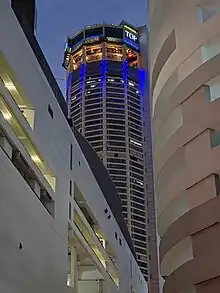
The first publicly accessible observatory decks at Komtar were between the 57th to 60th floors of the skyscraper. On 15 November 1989, the main observatory deck, the Tower Tourist Centre, was inaugurated at the 58th floor.[150] A duty-free shop, the Metropolitan Duty-Free Shop, opened at the 57th floor in mid-February 1990. The 59th and 60th floors housed a Chinese restaurant known as the Tower Palace. Other attractions include a video room and an amphitheatre for cultural shows.[151] The actual top floor, the 65th floor, was used as a helipad.[152]
Between 2014 and 2016, the top floors of the skyscraper were rebuilt in an extension program known as The Top, which includes the addition of three upper stories and a complete overhaul of all publicly accessible portions in the complex.[146] A new observatory deck known as Window of the Top was constructed at the 65th floor while an open-air deck was built at the 68th floor. Window of the Top, which stood at a height of 239 metres (784 ft), was only accessible through an express lift at the 5th floor.[127] Visitors could view up to 150 kilometres (93 mi) away from the deck, which includes parts of Seberang Perai and Kedah across the Penang Strait.[153] Other attractions on Window of the Top include a souvenir store and an outdoor rope course.[154] The 68th floor, standing at a height of 246.3 metres (808 ft), featured a restaurant called Top View and a semi-circle skywalk which extends beyond the main building.[155][156]
Podium
| Anchor tenants in Komtar | |
|---|---|
| BFO Dalit Cinema | 1981–1999 |
| Super Komtar | 1986–2005 |
| Yaohan | 1988–1998 |
| Popular | 1991–2021 |
| Aktif Lifestyle | 1998–2004 |
| Parkson Aktif | 2004–2005 |
| Pacific | 2008–present |
The podium at Komtar, which encompasses the 1st to 4th floor, contains a shopping complex which opened in 1976. Komtar had enjoyed the status of northern Malaysia's only shopping complex, creating a retail monopoly with high rental returns, comparable to the Sungei Wang Plaza in Kuala Lumpur in the late-1970s. This situation, which persisted throughout the 1980s, was described as a "shopping centre vacuum".[157]
The Dalit Cinema, operated by BFO, opened on 8 August 1981 as Komtar's first anchor tenant.[158] Super Komtar opened on 6 December 1986 as the first department store in the complex.[159][160] At the end of the 1980s, it became one of the most profitable and popular department stores in the country.[161][162] Japanese retail group Yaohan opened at Komtar in November 1988, becoming its first major foreign tenant. It had a staff of 350 and occupied an area of 130,000 square feet (12,000 m2).[163] The first Pizza Hut and White Castle outside of Kuala Lumpur opened at Komtar on January 1989 and 14 June 1989 respectively.[164][165][166] Singaporean bookstore chain Popular opened at the complex on 7 August 1991, which operated until 28 November 2021.[167][168] In 1992, both Yaohan and Metrojaya mooted the idea of building separate department complexes under phase 2E and phase three of the complex, but were never built.[74][77]
On 30 December 1997, Yaohan rebranded itself as Aktif Lifestyle after its Japanese parent company went bankrupt.[169][170] Aktif Lifestyle would face financial difficulties and in 2004 the store was bought out by Parkson, becoming Parkson Aktif.[171][172][173] The department store closed in 2005.[174] It was replaced by the ICT Digital Mall, which opened on 1 September 2010 as a "tech plaza".[175][176] Super Komtar would cease operations on 9 March 2005, remaining abandoned for two years before re-opening as Pacific on 17 December 2008.[119][177][178] In 2009, a large section of the podium was renovated into a pedestrian mall known as Komtar Walk, but failed to attract visitors and was abandoned in 2019 due to legal disputes between its operator and state authorities.[123] The mall was demolished and rebuilt in January 2023.[179]
Transportation
.jpg.webp)
Komtar is served by a bus terminal of the same name, which functions as the main interchange station for Rapid Penang, the sole public transport operator in George Town. Previously, the main interchange station at the city was the Prangin Road Bus Station, which had been the bus terminal for private bus companies, such as the Hin Company (Tanjung Bungah–Batu Ferringhi), the Lim Seng Seng Company (Ayer Itam), and the Yellow Bus Company (Jelutong–Bayan Lepas). However, the bus terminal shut down in 1990 for the construction of Prangin Mall.[69]
Since the early 2000s, Komtar has been proposed to contain terminal stations of potential light rail transit and monorail lines, primarily the Bayan Lepas LRT line.[180] Komtar is also the terminal station for the proposed George Town tram line.[181]
Other buildings
Besides the main complex, three other structures stood at the site. The oldest was a 470-suites, 17-storey hotel block which opened as the Shangri-La Hotel on 2 April 1986.[67][68] It was rebranded as the Traders Hotel on 1 April 2006, and as Hotel Jen in late-2014.[182][183] An auditorium in the shape of a geodesic dome, known as the Tunku Hall, was built at the roof of the podium in July 1986.[38] Inspired by The Tech in San Jose, the auditorium was repurposed as a science museum in 2016.[184] Two further shopping malls were constructed east of the complex; Prangin Mall (phase 4) opened in 2001, while 1st Avenue (phase 3) opened in 2010.[96][97]
 Komtar Walk along Prangin Road, 2010.
Komtar Walk along Prangin Road, 2010..jpg.webp) Prangin Mall at Tek Soon St, 2022.
Prangin Mall at Tek Soon St, 2022.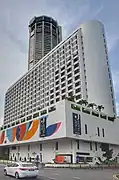 Jen Hotel, with Komtar in the foreground, 2021.
Jen Hotel, with Komtar in the foreground, 2021. 1st Avenue (phase three), along Magazine Rd., 2023.
1st Avenue (phase three), along Magazine Rd., 2023.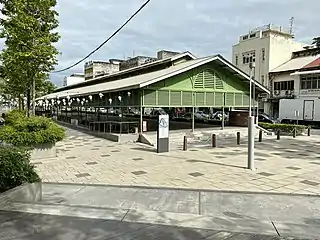 Sia Boey Park, 2021.
Sia Boey Park, 2021.
Logo and branding

1973–1993 and 1993–2001 logos of the World Trade CenterThe original design of Komtar's logo was a minimalistic outline of the complex resembling the letters "TAR" – an abbreviation of the complex's name. In 2015, a new logo was introduced featuring the words "Komtar" in red to symbolise ong, the Hokkien word for auspicious, with the letter "T" as a hand-drawn image of the tower.[185][186]
Legacy
On the city centre and future developments
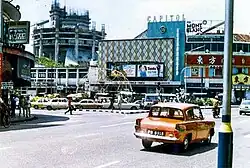
The construction of Komtar resulted in the destruction of a huge section of the heritage quarters along Penang Road and the Prangin Canal, which had been an important enclave of the Chinese riverine settlement in George Town.[187] Over three hundred historic landmarks were demolished in the process, including the former Jinricksha Office, the former campus of Li Tek Primary School, and the Capitol and Oriental Emporium.[188][189][190] Gladstone Road, which ran from the Magazine Circus to the west and Carnavon Street to the east, was built over and disappeared under the complex, leaving a remnant at its eastern end that was removed in 2000.[191][192]
With the rise of the service industry in Penang after its industrialisation in the 1980s, Komtar's status as a large centralised financial district decimated smaller, traditional businesses in the city centre.[193][194] The irreversible changes towards the city centre following Komtar's completion were cited as one of the main factors leading to a rise of heritage preservation movements in Penang.[10] In 1986, the Penang Heritage Trust was founded, and in 1989 the first heritage conservation enactments were passed in the state legislature.[195] These efforts culminated in the establishment of a conservation zone, involving a 269 acres (109 ha) "heritage core zone" and a 390 acres (160 ha) "buffer zone" inscribed by UNESCO in 2008, which banned any alterations to all historic structures in George Town's urban core.[196]
Komtar was a centrepiece under the ideal Wawasan 2020, which encouraged urban construction and renewal throughout Malaysian cities, leading to a development boom. Private development applications in Penang peaked in the mid-1990s, which made the heritage quarters susceptible to demolition like those of Komtar, a trend that was only halted after the Asian financial crisis in 1997.[197] Despite this, following the complex's completion in 1985, the Penang state government would never again undertake any urban redevelopment programmes within the heritage quarters, instead opting for land reclamation. This strategy, first employed in the expansion of the Bayan Lepas Free Industrial Zone in the late 1970s, allowed state authorities to skip negotiations and avoid overly complicated resettlement agreements, thereby reducing acquisition costs.[198] From 1980 to 2000, almost all of George Town's east coast was reclaimed, and by 2015 total reclaimed land in the city was estimated to be 9.5 square kilometres (3.7 sq mi) in area.[199]
Gallery
_(cropped).jpg.webp) From Ria Road, 2010.
From Ria Road, 2010._(cropped%252C_4to3_portrait).jpg.webp) View from Burma Road, 2011.
View from Burma Road, 2011._(cropped%252C_borderless).jpg.webp) From Penang Road, 2010.
From Penang Road, 2010..jpg.webp) Komtar and its surrounding skyline from Penang Hill, 2019.
Komtar and its surrounding skyline from Penang Hill, 2019.
.jpg.webp) Exterior of Komtar with clan jetties in foreground, 2003.
Exterior of Komtar with clan jetties in foreground, 2003..jpg.webp) From Kek Lok Si Temple, 2009.
From Kek Lok Si Temple, 2009..jpg.webp) Across Penang Strait towards Seberang Perai, 2012
Across Penang Strait towards Seberang Perai, 2012
Notes
- ↑ 1990 value for phases one and two; equivalent to RM642.5 million in 2023 value.
- ↑ Previously 231.7 metres (760 ft) from 1985 to 2016.
- ↑ Previously 65 storeys from 1985 to 2016.
- ↑ Not to be confused with a nearby plot of land at the junction between Prangin Road and Penang Road which is also designated as phase 2E.
See also
References
Citations
- ↑ Komtar at Emporis
- ↑ "Komtar". CTBUH Skyscraper Center.
- ↑ "Komtar". SkyscraperPage.
- ↑ Komtar at Structurae
- ↑ Choo 2021.
- 1 2 3 4 5 6 7 Devi & Filmer 2008.
- ↑ Nambiar 2017.
- 1 2 3 Penang Monthly 2016.
- ↑ Jenkins 2008, p. 119–121.
- 1 2 Teh & Yoh 2016, p. 22.
- ↑ Tan 2008a, p. 18.
- 1 2 3 4 Speechly 2016.
- 1 2 Naidu 2012, p. 767.
- ↑ Nambiar 2019.
- ↑ PDC & GTWHI 2016, p. 3.
- ↑ Chong 2001, p. 12.
- 1 2 Mok 2019a.
- 1 2 Chong & Filmer 2012.
- ↑ Mok 2019b.
- ↑ Ang, Looram & Chimalapati 2020, p. 163–164.
- ↑ Khoo 2003, p. 120.
- ↑ Tew 2001, p. 221.
- ↑ Teh 2017.
- ↑ Cheng, Li & Ma 2014, p. 633.
- ↑ Jenkins 2008, p. 95.
- ↑ Arup 2023.
- ↑ Singapore Herald 1970, p. 14.
- 1 2 Lim 1972, p. A16.
- 1 2 Tew 2001, p. 224.
- ↑ Jenkins 2008, p. 97.
- 1 2 3 New Nation 1975, p. 11.
- 1 2 3 4 5 Jenkins 2008, p. 96.
- ↑ New Straits Times 1974e, p. 12.
- 1 2 The Straits Times 1975, p. 16.
- ↑ New Straits Times 1986a, p. 7.
- 1 2 Lee 1986, p. 11.
- ↑ Haniff 1987, p. 11.
- 1 2 3 New Straits Times 1986d, p. 4.
- 1 2 New Straits Times 1986c, p. 5.
- ↑ New Straits Times 1974f, p. 11.
- ↑ Sharifah & Sia 2004, p. 717.
- ↑ Lim 1972, p. A32.
- 1 2 3 The Straits Times 1974b, p. 7.
- 1 2 New Nation 1974, p. 4.
- 1 2 New Straits Times 1974a, p. 1.
- ↑ The Straits Times 1974a, p. 7.
- 1 2 Jenkins 2008, p. 95–96.
- 1 2 The Straits Times 1973b, p. 5.
- ↑ The Straits Times 1973a, p. 6.
- ↑ Rahman 1985, p. 36.
- ↑ The Straits Times 1973d, p. 10.
- ↑ The Straits Times 1973c, p. 19.
- ↑ New Straits Times 1974g.
- 1 2 3 New Straits Times 1997b, p. 2.
- 1 2 3 New Straits Times 1985a, p. 4.
- 1 2 The Straits Times 1976, p. 16.
- ↑ New Straits Times 1974b, p. 22.
- ↑ New Straits Times 1974c, p. 8.
- ↑ New Straits Times 1980, p. 14.
- ↑ Cheah 1983, p. 8.
- ↑ New Straits Times 1983a, p. 13.
- ↑ Lo, Tern Chern (14 September 2023). "Living far away from home, yearning for local food". The Star.
- ↑ New Straits Times 1983b, p. 14.
- ↑ The Straits Times 1984, p. 13.
- ↑ New Straits Times 1984, p. 4.
- ↑ New Straits Times 1985b, p. 8.
- 1 2 3 New Straits Times 1986b, p. 11.
- 1 2 The Business Times 1985, p. 14.
- 1 2 3 4 Lim 1990b, p. 3.
- 1 2 New Straits Times 1990b, p. 3.
- ↑ New Straits Times 1989d, p. 7.
- ↑ New Straits Times 1991, p. 15.
- 1 2 Ahmad 1991, p. 15.
- 1 2 Taib 1992, p. 4.
- ↑ New Straits Times 1995, p. 28.
- ↑ New Straits Times 1996b, p. 25.
- 1 2 New Straits Times 1990c, p. 24.
- 1 2 Lim 1997, p. 18.
- ↑ The Star 1997, p. 18.
- ↑ New Straits Times 1996a, p. 23.
- ↑ New Straits Times 1997e, p. 7.
- 1 2 New Straits Times 1997a, p. 13.
- 1 2 Emmanuel 1997a, p. 2.
- 1 2 3 James & Emmanuel 1997, p. 2.
- ↑ Cheah 1997, p. 15.
- ↑ Lee 1997, p. 4.
- ↑ New Straits Times 1997h, p. 17.
- ↑ New Straits Times 1997d, p. 3.
- ↑ New Straits Times 1997f, p. 6.
- ↑ New Straits Times 1997g, p. 8.
- ↑ Emmanuel 1997b, p. unk..
- ↑ New Straits Times 1997i, p. 3.
- ↑ Utterback 1997, p. 1–2.
- ↑ Lim 1999, p. 18.
- ↑ Prangin Mall 2023.
- 1 2 Tan & Tan 2008.
- 1 2 The Edge 2010b.
- ↑ The Edge 2009.
- ↑ Dielenberg 2010.
- ↑ Lim 1991.
- ↑ Lai 2012.
- ↑ Mok 2016a.
- ↑ Khoo 2020.
- ↑ Bulletin Mutiara 2019.
- ↑ Dermawan 2023.
- ↑ New Straits Times 1974d, p. 10.
- 1 2 James 1997, p. unk..
- ↑ Goh 2014, p. 92.
- ↑ New Straits Times 1976, p. 7.
- ↑ "'Pay more for land acquired' call to Penang Govt". New Straits Times. 7 January 1976. p. 11.
- ↑ New Straits Times 1981b, p. 10.
- ↑ Todd 1985, p. 10.
- ↑ New Straits Times 1973, p. 4.
- ↑ Lim 1985, p. 3.
- ↑ Veerasingam, Moses & Ahmad 1985, p. 11.
- ↑ Hassan 1984, p. 6.
- ↑ The Straits Times 1997, p. 22.
- ↑ Huang 2023.
- 1 2 Yeoh 2008, p. 5(B)(XVIII).
- ↑ Fabros, Aya (30 September 2011). "The (Non)Citizens of Komtar: Transnational Migrants Forging Their Own Communities in Malaysia". Global Dialogue.
- ↑ Bulletin Mutiara 2021.
- ↑ Loh & Tan 2015.
- 1 2 Sekaran 2022.
- ↑ The Star 2008.
- 1 2 New Straits Times 2007.
- ↑ Tan 2008b.
- 1 2 3 The Edge 2010c.
- ↑ Malay Mail 2013.
- ↑ The Star 2016.
- ↑ Li 2016b.
- ↑ Lo 2018.
- 1 2 CTBUH 2023.
- ↑ The Straits Times 1986, p. 13.
- ↑ New Straits Times 1988a, p. 15.
- ↑ The News-Journal 1990, p. 8H.
- ↑ Bahrin 1985, p. 1.
- ↑ Tew 2001, p. 225.
- ↑ The Edge 2015.
- ↑ Penang Heritage Trust 2023.
- ↑ Penang Sentral 2023.
- ↑ Urban Transformation Centre 2023.
- 1 2 Bulletin Mutiara 2020.
- ↑ New Straits Times 1990a, p. 3.
- ↑ New Straits Times 1983c, p. 13.
- ↑ See Hua Daily News 2015.
- 1 2 Hilmy 2023.
- ↑ New Straits Times 1992, p. 3.
- ↑ See 2007.
- ↑ The Star 2020.
- ↑ New Straits Times 2000, p. 6.
- ↑ New Straits Times 1989e, p. 4.
- ↑ Zaknic, Smith & Rice 1998, p. 72.
- ↑ The Straits Times 2016b.
- ↑ Chow 2018.
- ↑ The Straits Times 2016a.
- ↑ Li 2016a.
- ↑ Chan 2004, p. 11–12.
- ↑ New Straits Times 1981a, p. 6.
- ↑ New Straits Times 1986e, p. 8.
- ↑ New Straits Times 1989f, p. 11.
- ↑ Lim 1989, p. 19.
- ↑ New Straits Times 1989a, p. 19.
- ↑ New Straits Times 1988b, p. 15.
- ↑ New Straits Times 1988c, p. 18.
- ↑ Au 1989, p. 20.
- ↑ New Straits Times 1989b, p. 17.
- ↑ Yee 2022, p. 5–8.
- ↑ The Star 2021.
- ↑ New Straits Times 1998, p. 15.
- ↑ New Straits Times 1997j, p. 24.
- ↑ Kang 2004, p. B3.
- ↑ Dalip 2004, p. 5.
- ↑ Adam 2004, p. B7.
- ↑ Sin Chew Daily 2010.
- ↑ The Star 2010.
- ↑ The Edge 2010a.
- ↑ Filmer 2008.
- ↑ Oriental Daily News 2015.
- ↑ "Komtar Walk to come alive with activities, more shops opening". The Star. 15 December 2022.
- ↑ Penang Infrastructure Corporation 2018.
- ↑ Penang Property Talk 2016.
- ↑ Williams 2006.
- ↑ Oates 2014.
- ↑ Mok 2016b.
- ↑ Tan, Sin Chow (21 August 2015). "Graphic designer clinches RM3,000 prize in Komtar logo design contest". The Star. Archived from the original on 24 August 2015.
- ↑ Looi, Sue-Chern (18 August 2015). "Penang's Komtar gets logo designed by Bukit Mertajam designer". The Edge.
- ↑ "National registry needed for heritage buildings". The Star. 28 February 2023.
- ↑ Mok, Opalyn (4 February 2023). "Could Penang lose another heritage building to developers? Spotlight on former Rex Cinema building with Art Deco architecture". Malay Mail.
- ↑ Khoo 2003, p. 110–111.
- ↑ Sekaran, R (1 October 2020). "Strokes of sweet nostalgia". The Star.
- ↑ Netto, Anil Noel (9 November 2011). "Old Penang: Magazine Circus". aniletto.com.
{{cite web}}: CS1 maint: url-status (link) - ↑ Boon, Raymond (7 July 2009). "Loss of old Penang streets". Life in Penang, is more beautiful.
- ↑ Zhao, Wong & Hanafi 2019, p. 523.
- ↑ Zhao, Long; Wong, Bun Win; Hanafi, Zulkifli (2019). "The evolution of George Town's urban morphology in the Straits of Malacca, late 18th century-early 21st century". Frontiers of Architectural Research. 8 (4): 513–534. doi:10.1016/j.foar.2019.09.001 – via Elsevier Science Direct.
- ↑ Teh & Yoh 2016, p. 15.
- ↑ Teh & Yoh 2016, p. 15–16.
- ↑ Cheng, Li & Ma 2014, p. 633–634.
- ↑ Tan, Joceline (29 June 1988). "Land reclamation: The only answer for Penang". New Straits Times. p. 6.
- ↑ Yew, Johnny (5 December 2021). "Penang reclamations: then and now". The Star. Archived from the original on 5 December 2021.
{{cite news}}: CS1 maint: unfit URL (link)
Bibliography
Publications
- Jenkins, Gwynn (2008). Contested Space: Cultural Heritage and Identity Reconstructions: Conservation Strategies Within a Developing Asian City. Volume 20, Freiburger Sozialanthropologische Studien Series. LIT Verlag Münster. ISBN 9783825813666 – via Google Books.
- Kharas, Homi; Zeufack, Albert; Majeed, Hamdan (2010). Cities, people & the economy: A study on positioning Penang (PDF). Kuala Lumpur: Khazanah Nasional. ISBN 9789834419332.
- Khoo, Salma Nasution (2003). Penang Postcard Collection: 1899-1930s (Hardcover ed.). George Town: Areca Books. ISBN 9789832885009.
- Lim, Chong Keat (1972). Central Area Redevelopment Plan for Penang (1962–1986). George Town: Architects Team Three. pp. A16–A32 – via M+.
- Naidu, Dinesh (2012). Southeast Asian Personalities of Chinese Descent: A Biographical Dictionary. Vol. 1. Singapore: ISEAS Publishing. pp. 766–768. ISBN 9789814345217 – via Docomomo Singapore.
- Ooi, Kee Beng; Goh, Ban Lee (2010). "Political Masters and Master Plans". Pilot Studies for a New Penang. Singapore: Institute of Southeast Asian Studies. pp. xx–xxx. ISBN 9789814279697.
- Penang Development Corporation; George Town World Heritage Incorporated (2016). "3.1: Historical Background". Sia Boey Integrated Site Management Plan (PDF) (Report). George Town.
- Tew, Peng Kooi (2001). "Bab 7: Penganjur Kebajikan Rakyat" [Chapter 7: Promoter of social welfare] (PDF). Kepemimpinan Tun Dr. Lim Chong Eu di Pulau Pinang sehingga 1974 [Premiership of Tun Dr. Lim Chong Eu in Penang until 1974] (PDF) (Master thesis) (in Malay). Kuala Lumpur: University Malaya. pp. 205–267.
- Zaknic, Ivan; Smith, Matthew; Rice, Dolores (1998). 100 of the World's Tallest Buildings. Australia: Images Publishing. pp. 72–73. ISBN 187549832X.
- Yee, Lai Lan (2022). "功成身退:光大大众书局" [A pioneering success and a fond farewell]. Popular News (in Chinese). Singapore (139): 5–8.
Academic journals
- Teh, Yee Sing; Yoh, Sasaki (2016). "Rehabilitation and Conservation Framework of Old Inner Area in Asian Mega Cities" (PDF). International Journal of the Malay World and Civilisation. 4 (Special Issue 2): 13–24. doi:10.17576/IMAN-2016-04SI2-02 (inactive 26 December 2023). Archived from the original (PDF) on 1 November 2018.
{{cite journal}}: CS1 maint: DOI inactive as of December 2023 (link) - Ang, Ming Chee; Looram, Charlotte Papillaud; Chimalapati, Virajitha (2020). "Community archaeology in Sia Boey Integrated Management Plan, Malaysia". Journal of Community Archaeology & Heritage. 7 (3): 161–170. doi:10.1080/20518196.2020.1767386. ISSN 2051-8196. S2CID 221051681 – via Taylor & Francis.
- Nesadurai, Helen E. S. (1991). "The Free Trade Zone In Penang, Malaysia: Performance And Prospects". Southeast Asian Journal of Social Science. 19 (1/2): 103–138. doi:10.1163/080382491X00069. ISSN 0303-8246. JSTOR 24491733 – via JSTOR.
- Goh, Daniel P. S. (2014a). "Between History and Heritage: Post-Colonialism, Globalisation, and the Remaking of Malacca, Penang, and Singapore". TRaNS: Trans-Regional and -National Studies of Southeast Asia. 2 (1): 79–101. doi:10.1017/trn.2013.17. ISSN 2051-364X.
- Hutchinson, Francis Edward (2008). ""Developmental" States and Economic Growth at the Sub-National Level: The Case of Penang". Southeast Asian Affairs. 2008: 223–244. doi:10.1355/SEAA08M. ISSN 0377-5437. JSTOR 27913361. S2CID 153360758 – via JSTOR.
- Cheng, Edmund W.; Li, Anthony H. F.; Ma, Shu-Yun (2014). "Resistance, Engagement, and Heritage Conservation by Voluntary Sector: The Case of Penang in Malaysia". Modern Asian Studies. 48 (3): 617–644. doi:10.1017/S0026749X1200087X. ISSN 0026-749X. JSTOR 24494662. S2CID 143534017 – via JSTOR.
- Snider, Nancy L. (1968). "What Happened in Penang?". Asian Survey. 8 (12): 960–975. doi:10.2307/2642150. ISSN 0004-4687. JSTOR 2642150 – via JSTOR.
- Sharifah, Fairuz Syed Fadzil; Sia, Sheau-Jiunn (2004). "Sunlight control and daylight distribution analysis: the KOMTAR case study". Building and Environment. 39 (6): 713–717. doi:10.1016/j.buildenv.2003.12.009 – via Elsevier.
- Utterback, Christine (1997). "New York Central Park" (PDF). PHT Newsletter. George Town: Penang Heritage Trust (38/39): 1–2.
- Goh, Daniel P.S. (2014). "Between History and Heritage: Post-Colonialism, Globalisation, and the Remaking of Malacca, Penang, and Singapore" (PDF). TRaNS: Trans -Regional and -National Studies of Southeast Asia. 2 (1): 79–101. doi:10.1017/trn.2013.17.
News reports, advertisements and public notices
- "5 Killed in Malaysian Rioting Over Devaluation; 91 Hurt in Penang in 6 Hours of Chinese-Malay Fighting - Communists Blamed". The New York Times. Associated Press. 25 November 1967. p. 6. ISSN 0362-4331.
- "Loss of status: 'No other choice...'". The Straits Times. 24 May 1967. p. 6.
- "Ooi: We lost it last year". The Straits Times. 24 May 1967. p. 6.
- "The gloomy future for Penang". The Straits Times. 13 August 1968. p. 10.
- "Penang Plight's". The Straits Times. 15 August 1968. p. 10.
- "NOW WONG SAYS IT... Penang no longer a free port". The Straits Budget. 16 October 1968. p. 10.
- "$200 mil wanted for new urban centre". The Straits Times. 14 November 1973. p. 5.
- "Multi-million dollar civic centre for Penang". The Straits Times (Malaysian ed.). 5 September 1973. p. 6.
- "Tawaran-tawaran untuk kerja 'Piling to Phase 1-A, Penang Urban Centre'". The Straits Times (Malaysian ed.). 4 December 1973. p. 19.
- "Tun in Penang". The Straits Times. 24 December 1973. p. 10.
- "Penang's $200 mil project". The Straits Times. 1 January 1974. p. 7.
- "Lim: Urban Centre a victory for progressive planning..." The Straits Times. 2 January 1974. p. 7.
- "Kompleks Angkasa Perdana Pulau Pinang". The Straits Times. 25 July 1975. p. 16.
- "Penang's $200 m pace-setting complex". The Straits Times. 1 December 1976. p. 16.
- "Hundreds jolted as tremor shakes building". The Straits Times. 30 May 1984. p. 13.
- "It's Set for November 10th". The Straits Times. 3 November 1986. p. 13.
- "Traders in Penang road live in fear of building collapse". The Straits Times. 8 March 1997. p. 22.
- "Rainbow Skywalk, the highest in Malaysia, set to open at Komtar in Penang". The Straits Times. 7 December 2016.
- "Malaysia's 'Window of the Top' gives visitors breathtaking view of Penang". The Straits Times. 17 December 2016.
- ""Urban centre will only bring $200 million of misery"". New Straits Times. 22 November 1973. p. 4.
- "Penang-mainland link by 1978: A bridge it is". New Straits Times. 1 January 1974. p. 1.
- "Urban Centre". New Straits Times. 9 January 1974. p. 22.
- "That Penang Urban Centre: Going up–a 45-storey tower". New Straits Times. 1 May 1974. p. 8.
- "Penang battle grows louder". New Straits Times. 19 August 1974. p. 10.
- "Giving the people a bigger slice of the cake". New Straits Times. 31 August 1974. p. 12.
- "Buckminster Fuller's designs for Penang". New Straits Times. 11 October 1974. p. 11.
- "Penang's growing economic strength". New Straits Times. 25 October 1974. p. 10.
- "Penang corp accused of not following rules". New Straits Times. 19 February 1976. p. 7.
- "Federal govt to take over State office complex". New Straits Times. 15 July 1980. p. 14.
- "New look for six areas in George Town". New Straits Times. 8 August 1981. p. 6.
- "Komtar will be an eyesore, says US don". New Straits Times. 6 November 1981. p. 10.
- "Fire guts upper floors of Penang skyscraper". New Straits Times. 24 January 1983. p. 13.
- "Uniform Building. Fey-Laws Almost Ready". New Straits Times. 21 February 1983. p. 14.
- "$20m dilemma for Penang Council". New Straits Times. 7 March 1983. p. 13.
- Cheah, S. C. (23 June 1983). "Largest roof garden for Komtar project". New Straits Times. p. 8.
- Hassan, Khairuddin (9 August 1984). "House prices: No rise for the last six months". New Straits Times. p. 6.
- "Tun Dr Awang to leave his mark on Komtar Tower". New Straits Times. 27 December 1984. p. 4.
- "Komtar to have earthquake resistant features". New Straits Times. 16 February 1985. p. 4.
- Rahman, Shukor (6 February 1985). "Penang streets' colourful past". New Straits Times. p. 36.
- "Komtar Hotel Sdn. Bhd". New Straits Times. 11 May 1985. p. 8.
- Todd, Halinah (24 May 1985). "Penang: What economic future?". New Straits Times. p. 10.
- Bahrin, Karina (5 November 1985). "Komtar's where the teenage action is". New Straits Times. p. 1.
- Veerasingam, Visa; Moses, Balan; Ahmad, Fizi (13 November 1985). "Abdullah on aims of student unity scheme". New Straits Times. p. 11.
- Lim, Eng Been (19 November 1985). "Lim – a twilight of a political maestro". New Straits Times. p. 3.
- "Tender Notice: Kompleks Tun Abdul Razak Pulau Pinang – Subphase 1D Geodesic Dome". New Straits Times. 7 February 1986. p. 7.
- "40% opening discount at Penang's finest address". The Straits Times. 12 March 1986. p. 11.
- "Work in Full Swing on Komtar Geodesic Dome". New Straits Times. 14 May 1986. p. 5.
- Lee, Keng Fatt (8 June 1986). "City's Dome of Pride". New Straits Times. p. 11.
- "Tunku touched by State Govt's gesture". New Straits Times. 1 July 1986. p. 4.
- "Notis". New Straits Times. 20 October 1986. p. 8.
- Haniff, Mokhtar (17 April 1987). "'Hall in Komtar can hold 1,875 people'". New Straits Times. p. 11.
- "Menara Maybank tallest". New Straits Times. Bernama. 11 June 1988. p. 15.
- "Yaohan to open store at Komtar". New Straits Times. 14 July 1988. p. 15.
- "Pizza Hut Plans To Open 5 New Outlets". New Straits Times. 26 October 1988. p. 18.
- Lim, Kean Liang (22 February 1989). "Super Komtar proves a good buy; GTH forcasts $6.4 million profit". New Straits Times. p. 19.
- "GTH's Komtar buy is fair, says CIMB". New Straits Times. 26 February 1989. p. 19.
- Au, Foong Yee (14 June 1989). "Aggressive opening by White Castle". New Straits Times. p. 20.
- "White Castle doing better than expected". New Straits Times. 19 July 1989. p. 17.
- "Penang turning into an island of filth". New Straits Times. 24 October 1989. p. 13.
- "Kompleks Tun Abdul Razak (Komtar) Phase 2E–Sale of Land by Tender". New Straits Times. 31 October 1989. p. 7.
- "Komtar's latest eatery, shopping centres". New Straits Times. 14 November 1989. p. 4.
- "3rd year joy in Komtar woos crowd". New Straits Times. 4 December 1989. p. 11.
- "$45m buy: Papers done after six years". New Straits Times. 9 January 1990. p. 3.
- "Komtar raked in $185m for state government". New Straits Times. 12 June 1990. p. 3.
- "Yaohan to build $129 million department store". New Straits Times. 31 July 1990. p. 24.
- Lim, Ai Lee (12 September 1990). "Penang's famous market". New Straits Times. p. 3.
- Lim, Ai Lee (12 September 1990). "Other side of Prangin Road". New Straits Times. p. 3.
- Lim, Ai Lee (9 July 1991). "George Town to buy land in Komtar for $109m". New Straits Times. p. 14.
- Ahmad, Baidura (7 August 1991). "Metrojaya confident of rewarding years ahead". New Straits Times. p. 15.
- "Metrojaya to spend $47 million on complex". New Straits Times. 10 August 1991. p. 15.
- Taib, Harris Iskandar (21 May 1992). "Retail giant reaches out to Penang". New Straits Times. p. 4.
- "Malaysia's first indoor golf facility opens in Penang". New Straits Times. 21 July 1992. p. 3.
- "PMI hopes to benefit from Asian economies". New Straits Times. 17 July 1995. p. 28.
- "Penas Group to build five shopping centres". New Straits Times. 9 February 1996. p. 23.
- "Metrojaya looking for sites outside Klang Valley". New Straits Times. 11 April 1996. p. 25.
- "Penang to probe cause of cracks at Komtar". New Straits Times. 25 January 1997. p. 13.
- James, Agnes (3 February 1997). "Affected residents want mall project discontinued" (PDF). New Straits Times. pp. unk.
- "Ikram report will decide fate of Prangin project". New Straits Times. 21 February 1997. p. 2.
- "Proposed mall touted a shopping paradise". New Straits Times. 21 February 1997. p. 2.
- James, Agnes; Emmanuel, Marine (22 February 1997). "Prangin Mall 'cause of cracks'". New Straits Times. p. 2.
- Emmanuel, Marine (2 March 1997a). "Checks on Komtar Tower show building is safe". New Straits Times. p. 2.
- "RM6 million more to remedy Prangin Mall woes". New Straits Times. 6 March 1997. p. 3.
- "Fewer cracks around Prangin Mall project". New Straits Times. 9 March 1997. p. 7.
- Lee, Keng Fatt (23 March 1997). "Affected parties may get data on cracks". New Straits Times. p. 4.
- "No lifting yet of stop-work order, says TAC". New Straits Times. 13 April 1997. p. 6.
- "Stop work order on mall project may be lifted". New Straits Times. 11 May 1997. p. 8.
- "Koh: Mall builders must submit RM2.3mil bond". New Straits Times. 31 May 1997. p. 17.
- "Art that reflects a watershed event". New Straits Times. 7 June 1997. p. 3.
- "Yaohan Holdings changes name to Aktif Lifestyle". New Straits Times. 25 November 1997. p. 24.
- "New corporate identity for group". New Straits Times. 6 January 1998. p. 15.
- Ng, Wai Koon (16 February 1999). "Authorities should try riding Penang buses". New Straits Times. p. 11.
- "Under an island spell". New Straits Times. 13 February 2000. p. 6.
- Kang, Siew Li (4 May 2004). "Parkson eyes 30pc pre-tax rise on strong Chinese store ops". New Straits Times. pp. B3.
- Dalip, Suryani (29 June 2004). "Mall's Aktif Lifestyle now Parkson Grand". New Straits Times. p. 5.
- Adam, Zurinna Raja (27 August 2004). "Aktif weighing core asset-injection proposal". New Straits Times. pp. B7.
- Chan, Richard (28 August 2004). "Knowing the retailer's mind". New Straits Times. pp. 11–12.
- "Proposal for school in Komtar". New Straits Times. 8 December 2007.
- Dermawan, Audrey (30 May 2023). "Penang LRT project set to start by year-end". New Straits Times.
- Nambiar, Pradeep (9 March 2017). "Penang's Komtar aims for world's tallest mural". Free Malaysia Today.
- Chow, Melissa Darlyne (27 January 2018). "Penang's Komtar to have highest rope course challenge at 239m". Free Malaysia Today.
- Nambiar, Predeep (29 July 2019). "Once-filthy Prangin Canal turned into an aquarium". Free Malaysia Today.
- Mok, Opalyn (1 July 2013). "Rapid Penang rolls on under Rapid Bus". Malay Mail.
- "Penang's iconic Komtar gets RM50m facelift". Malay Mail. 29 October 2013.
- Mok, Opalyn (22 June 2016). "Penang arts district relocated to Macallum Street; Sia Boey to be transport hub". Malay Mail.
- Mok, Opalyn (2 August 2016). "Penang Tech Dome: Where science and technology comes alive". Malay Mail.
- Mok, Opalyn (10 March 2019). "The making of Penang's very own Central Park in historic Sia Boey". Malay Mail.
- Mok, Opalyn (29 July 2019). "Clean Prangin Canal with fishes swimming in it is real, Penang agencies insist". Malay Mail.
- Lim, Ai Lee (7 January 1997). "Building of Komtar Phase 3 starts soon" (PDF). The Star. p. 18.
- Cheah, Ui-hoon (1 February 1997). "Make public details about project: Architect" (PDF). The Star. p. 15.
- "Groups to press for lifting of freeze" (PDF). The Star. 4 February 1997. p. 18.
- Emmanuel, Marina (15 June 1997b). "Developers of Prangin Mall get 20 conditions" (PDF). The Star. pp. unk.
- Chong, Kwee Kim (11 January 2001). "Paths of Yesteryear" (PDF). The Star. George Town. p. 12.
- Williams, Regina (13 March 2006). "Shangri-La Penang to be Traders Hotel". The Star.
- See, Bernard (16 June 2007). "Upgrading work on Komtar soon". The Star.
- Tan, David (6 April 2008). "Bringing life back to Komtar". The Star.
- Devi, K. Katsuri; Filmer, Andrea (4 May 2008). "Putting Komtar together again". The Star.
- "Penang to scrap 'Mini Putrajaya' project". The Star. 4 May 2008.
- Filmer, Andrea (7 October 2008). "New department store in Komtar". The Star.
- Tan, Sin Chow; Tan, Ann (3 November 2008). "Complex a boost to Komtar". The Star.
- "ICT mall in Komtar soon". The Star. 9 March 2010.
- Dielenberg, Priscilla (10 September 2010). "1st Avenue mall in George Town set to open doors in November". The Star.
- Chong, Kah Yuan; Filmer, Andrea (2 August 2012). "Remembering Sia Boey". The Star.
- Loh, Arnold; Tan, Royce (24 July 2015). "Disused cinema meets fiery end". The Star.
{{cite news}}: CS1 maint: ref duplicates default (link)
- "OWG to finish RM180mil Komtar revitalisation job by year-end". The Star. 20 January 2016.
- Lo, Tern Chern (2 February 2018). "World's tallest rope course opening in Komtar this month". The Star.
- "Bus terminal a hotspot for vagabonds". The Star. 2 April 2018.
- "Livelier Komtar with UTC opening on Monday". The Star. 15 August 2020.
- "Popular Bookstore in Komtar closing for good". Metro. The Star. 30 October 2021.
- Sekaran, R (13 April 2022). "Spicing up the scene in city centre". The Star.
- Hilmy, Imran (5 July 2023). "Restoring Komtar's former retail glory". The Star.
- "Penang's 1st Avenue set to open in 3Q10". The Edge. 4 November 2009.
- "Penang ICT mall to open its door in September". The Edge. 12 April 2010.
- "Penang's 1st Avenue mall to open Sept". The Edge. 16 June 2010.
- "Komtar to be revitalised as Penang lookout point". The Edge. 17 August 2010.
- "Penang calls for proposals to revive Komtar's charm". The Edge. 18 August 2010.
- "Komtar's makeover will boost Only World revenue". The Edge. 23 April 2015.
- Khoo, Ethel (19 December 2020). "Transforming prime land into historic community park". The Edge.
- "3月5日与檳发展机构签租约‧"科技广场"料901启用" [Agreement signed with Penang Development Corporation on 5 March; "Tech Plaza" expected to open on September 1st]. Sin Chew Daily (in Chinese). 5 March 2010.
{{cite news}}: CS1 maint: url-status (link) - "光大钟无艳(上):光大复兴未尽美" [Komtar, the Zhong Wuyan (Part I): The never dying beauty of Komtar's rejuvenation]. Oriental Daily News (in Chinese). 17 October 2015.
- "光大顶楼惊传火灾 实为冒烟所致" [Reports of fire on top of Komtar proven false; caused by clouds]. See Hua Daily News (in Chinese). 6 November 2015.
- Li, Qiuyuan (12 April 2016). "光大长高 68楼注入新生命" [Komtar extends its height; new lease of life for 68 floors]. Kwong Wah Yit Poh (in Chinese). Archived from the original on 12 February 2020.
- Li, Qiuyuan (14 April 2016). "一起见证 光大蜕变" [Let us witness the change of Komtar]. Kwong Wah Yit Poh (in Chinese). Archived from the original on 9 February 2020.
- Huang, Fangqi (25 June 2023). "昔日最潮商場回春乏力 光大有望重生" [While the most popular shopping of the past may not return to its glory days, Komtar may be reborn]. Guang Ming Daily (in Chinese).
{{cite news}}: CS1 maint: url-status (link) - Huang, Fangqi; Wu, Jinxiang (26 September 2023). "街友不再聚集露宿 光大巴士站變整潔" [Vagabonds no longer gather here; Komtar bus terminal has become clean]. Guang Ming Daily (in Chinese).
{{cite news}}: CS1 maint: url-status (link)
- Lai, Lucia (2 August 2012). "Proposed Heritage Square for Penang". Citizens Journal.
- "Penang launches first Urban Archeological Park in the country". Bulletin Mutiara. 9 November 2019.
- "PDC calls for concerted efforts to solve Komtar safety and social issues". Bulletin Mutiara. 22 October 2021.
- "New era of government service in Komtar". Bulletin Mutiara. 14 August 2020.
- "打造更理想环境 槟岛市厅积极提升光大巴士总站" [Building a better environment; Penang Island City Council strives to upgrade Komtar bus terminal]. Bulletin Mutiara (in Chinese). 8 December 2023.
- "New urban centre for George Town". Singapore Herald. 18 November 1970. p. 14.
- Teh, Evelyn (1 December 2017). "Where the sea meets the city is where the world meets Penang". Penang Monthly. Archived from the original on 1 December 2017.
- "Raising Komtar". Penang Monthly. February 2016. Archived from the original on 21 October 2016.
- Tan, Jessinta (1 March 2008). "From an icon of progress...to a symbol of shame and neglect?". Today. p. 18.
- Choo, Jennifer (28 September 2021). "Architectural Icon: How Komtar, Penang's First Modernist Skyscraper, Changed The Face Of George Town". Tatler.
- "The bridge is a promise of the future". New Nation. 24 August 1974. p. 4.
- "Kompleks Angkasa Perdana Pulau Pinang". New Nation. 25 July 1975. p. 11.
- "We're proud to announce the perfect conference address". The Business Times. 29 November 1985. p. 14.
- "Pei". The Daytona Beach News-Journal. 14 January 1990. pp. 8H.
- Speechly, Soon-Tzu (6 June 2016). "Komtar: Malaysia's Monument to Failed Modernism". Failed Architecture. Retrieved 25 September 2023.
{{cite web}}: CS1 maint: url-status (link) - McCready, Alastair (8 July 2021). "1972, The Year That Transformed Penang". Southeast Asia Globe. Retrieved 27 September 2023.
- Mohammad Rosli, Syajaratulhuda (23 December 2022). "Bas percuma Cat Bridge untuk rakyat Pulau Pinang" [Free Cat Bridge bus for Penang citizens]. Sinar Harian (in Malay).
- Oates, Greg (2 September 2014). "Hotel Jen by Shangri-La is First Major Asian Brand to Target Millennials". Skift.
- "George Town Tram Line". Penang Property Talk. 4 May 2016.
- "Public Transport". penanginfra.com. Penang Infrastructure Corporation. 2018.
- "101 Line; Jeti–Tlk.Bahang". moovitapp.com. Moovit. 2022.
- "Menara KOMTAR". SkyscraperCenter. Council on Tall Buildings and Urban Habitat. 2023.
- "Arup – Malaysia". arup.com. Arup Group. 2023.
- "Penang State Contacts". pht.org. Penang Heritage Trust. 2023.
- "Penang State Government Agencies". penangsentral.com. Penang Sentral. 2023.
- "Visit us". prangin-mall.com. Prangin Mall. 2023.
- "Rapid Penang - Bus Service Info". Rapid Penang. Prasarana. 2023.
- "UTC Pulau Pinang". utc.my. Urban Transformation Centre. 2023.
- Lim, Gim Soon (1999). "Soalan-soalan yang dikemukakan untuk mendapat jawapan-jawapan bertulis daripada Y.A.B Ketua Menteri" [Questions raised to receive written responses from The Honourable Chief Minister]. Mesyuarat Pertama Penggal Pertama Dewan Undangan Negeri Pulau Pinang Kesepuluh [Articles raised in the first session and first meeting of the tenth Legislative Assembly of Penang] (PDF) (in Malay). George Town: Penang State Legislative Assembly. p. 18.
- Yeoh, Soon Hin (2008). "6 soalan bertulis oleh ahli kawasan Paya Terubong YB Tuan Yeoh Soon Hin" [6 written questions from the state representative of Paya Terubong His Honorable Mr. Yeoh Soon Hin]. Mesyuarat Kedua Penggal Pertama Dewan Undangan Negeri Pulau Pinang Ke-duabelas [Articles raised in the second session and first meeting of the twelve Legislative Assembly of Penang] (in Malay). George Town: Penang State Legislative Assembly. pp. 5(B)(XVIII).
_(cropped_3to4_portrait).jpg.webp)
_(4to3).jpg.webp)